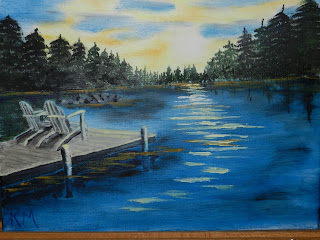St. Patrick’s Day has come and gone for another year. With
the flip of that calendar page went the need to wear green and an urge to
search lawns for lucky four-leaf clovers. The more common three-leaf variety
representing faith, hope, and love symbolized Ireland’s most famous saint. Add
a leaf to that trefoil and you get luck as well. Finding a shamrock with that extra
something is the difficulty. According to some statisticians, only one in 10,
000 possesses the lucky fourth.
As a kid, I loved the challenge of discovering any shamrock.
The same girl who struggled to spend 10 minutes solving a tough math problem could
wander with her eyes to the ground for an hour or two until she shouted she’d sighted
a fortune-enhancing chlorophyll producer.
What I’ve learned since is that paying attention to art instruction
would have improved my chances for success. Yes, painting and drawing classes
teach people how to spot the rare and unique.
When I was a youngster, I loved to draw and mess with clay,
but I never took the coursework seriously. I considered art class a place to
relax and have fun without straining my brain. Because I didn’t focus, I missed
lessons that could have changed how I understood my world.
Over the past three years, I’ve reconsidered my attitude
toward art and started taking as many painting and drawing classes as I can. What
I’ve discovered is that learning to shape, shade, and adjust hues and values trains
the mind to perceive. I thought I saw just fine all those years before I applied
myself to really looking at something. However, the trip home after my first
painting class revealed how many subtleties my untutored eye had missed.
Green and yellow are a multitude of hues. Study a grove of trees
or a wheat field and try to identify all the shades present. I bet you can’t
name all the colors right before your eyes.
Look at a lake, pond, or stream. Would one box of eight
crayons allow you to depict that view even if you’re good at blending and
shading? Could you do the job properly with a box of 64?
Examine the sky. Which part of it is lighter and which is
darker? Does this pattern occur every single day? Does an approaching storm alter
your observations?
How does incoming light affect a scene? Where do highlights
and shadows form at different times of day or under varying conditions?
Though I’m still in the early stages of developing an artist’s
eye, my few lessons have changed how I experience my world. I look for shifts
in color and form. I seek what’s different. I search for repetition. There’s
more to observe than I realized prior to stepping outside my comfort zone and putting
a paintbrush in my hand in my AARP years.
If only I’d paid
close attention to those long ago art teachers, my educated eye would have
zeroed in on so many more four-leaf clovers. What might I have done with that
extra good fortune . . .?


No comments:
Post a Comment